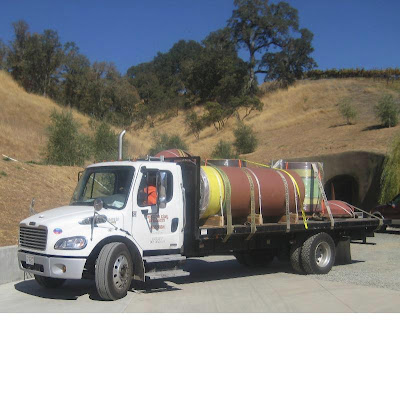
The following is an excerpt from Free Run Press: news & views from Saracina vineyards/ fall 2010
It describes wine fermenting tanks that are glazed with Leslie Ceramic Glazes. U-series underglazes and N-1 clear were used to paint broad bands of color on the exterior of the tanks. They are fired in huge kilns which soak the clay for 20 hours at 2029 degrees! Leslie's owner John Toki has provided extensive technical information during the development of the wine tanks.
"'It's the future...it's now,' pronounced Saracina Winemaker Alex
MacGregor, in describing the enormous, custom-made clay
fermenting and storage vessels that literally rolled into the Saracina winery this month. Experimenting with these 3000-
pound, custom-designed tubular tanks represents a natural evolution at our CCOF-certified winery and takes a step beyond the concrete tanks that have recently enjoyed some cache among
wine producers.
In 2009, John Fetzer, Mission Clay Products Owner Bryan Vansell, and Adjunct Professor at California College of the Arts (CCA) John Toki hatched the idea of modifying commercial clay
pipes, normally used for water systems in major metropolitan areas, for wine fermentation and storage. They recognized that fired clay was an ideal natural substance in which to ferment and
store wine. Clay pipes have a life-span of hundreds, even thousands of years, as demonstrated by the functional water pipes found at Pompeii and Ephesus in Turkey. Unlike clay amphorae that were used by the Greeks and Romans to store their wines, our tanks have a simple, tubular shape which make them ergonomically easy to move and echo the traditional shape
of modern stainless wine tanks.

Mission Clay Products, the largest commercial manufacturer of clay pipes in the country, was interested in expanding into new
industries and volunteered to produce these "beta" custom vessels. Vansell admits, "Over a 12-month period, we made 50 to create 6 that matched John Fetzer's specifications." He also
plans to include a wireless thermocouple inside so that our
winemaker can monitor the inside temperatures from his
computer.
Consulting with MacGregor regarding the properties he sought in traditional stainless steel tanks, Mission Clay's team designed
tubular clay vessels, some standing nine feet high, sealed the interior with beeswax for natural waterproofing, and applied non-toxic glazes (Leslie's!) to provide an aesthetically interesting surface
design. The clay allows the juice to breathe during the
fermentation process.

Not satisfied with functionality alone, CCA student Travis McFlynn, created figurative sculptures to sit atop the lids of the largest tanks. These tanks will be buried in the ground to sustain
the cool temperatures needed to ferment and store the wine, while the sculptural lids will protrude above the surface for easy
access.
Wine making, commerce, artistry and craftsmanship all came
together in this pioneering project."

A qvevri is a large clay vessel originally from Georgia in the Caucasus and dating back to about 6000 BC. It has an inside coat of beeswax, resembles an amphora without handles, and is used for the fermentation and storage of wine, often buried below ground level or set into the floors of large wine cellars.
ReplyDeletehttp://domainegeorgia.wordpress.com/
Very cool, thanks for adding this info to the post.
ReplyDeleteThis is so cool. I saw them installed at the winery but I did not really "get" that the figures were sitting on top of tanks...
ReplyDeleteVery nice. Yeah they bury the tanks to regulate the temperature of the tanks so all you see is the sculpture on top. I'll have to make it up there some day....
ReplyDeleteI'm curious. If the insides are coated with (bees)wax, how does the wine get affected by the clay? It should be completely isolated from it, no? What am I missing?
ReplyDeleteI have little idea, but there are many possible factors. Heat and conduction mainly come to mind as possible differences. The beeswax itself could be considered too.
Delete